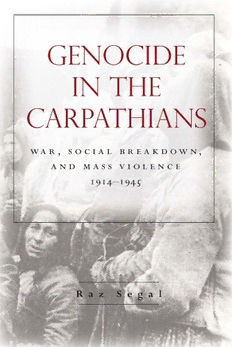
Genocide in the Carpathians: war, social breakdown, and mass violence, 1914-1945 PDF
Preview Genocide in the Carpathians: war, social breakdown, and mass violence, 1914-1945
Genocide in the Carpathians Stanford Studies on Central and Eastern Europe Edited by Norman Naimark and Larry Wolff Genocide in the Carpathians War, Social Breakdown, and Mass Violence, 1914–1945 Raz Segal Stanford University Press Stanford, California Stanford University Press Stanford, California ©2016 by the Board of Trustees of the Leland Stanford Junior University. All rights reserved. This book has been published with the assistance of the Yoran Schnitzer Foundation and the Stephen Roth Institute for the Study of Contemporary Antisemitism and Racism at Tel Aviv University. No part of this book may be reproduced or transmitted in any form or by any means, electronic or mechanical, including photocopying and recording, or in any information storage or retrieval system without the prior written permission of Stanford University Press. Printed in the United States of America on acid-free, archival-quality paper Library of Congress Cataloging-in-Publication Data Names: Segal, Raz, author. Title: Genocide in the Carpathians : war, social breakdown, and mass violence, 1914-1945 / Raz Segal. Other titles: Stanford studies on Central and Eastern Europe. Description: Stanford, California : Stanford University Press, 2016. | Series: Stanford studies on Central and Eastern Europe | Includes bibliographical references and index. Identifiers: LCCN 2016010624 (print) | LCCN 2016011000 (ebook) | ISBN 9780804796668 (cloth : alk. paper) | ISBN 9780804798976 (electronic) Subjects: LCSH: Genocide--Ruthenia (Czechoslovakia)--History--20th century. | Ruthenia (Czechoslovakia)--Ethnic relations--Political aspects. | World War, 1939-1945--Atrocities--Ruthenia (Czechoslovakia) | State-sponsored terrorism--Hungary--History--20th century. | Holocaust, Jewish (1939-1945)--Ruthenia (Czechoslovakia) | Hungary--Relations--Ruthenia (Czechoslovakia) | Ruthenia (Czechoslovakia)--Relations--Hungary. Classification: LCC DK508.9.Z35 S44 2016 (print) | LCC DK508.9.Z35 (ebook) | DDC 947.7/9084--dc23 LC record available at http://lccn.loc.gov/2016010624 Typeset by Bruce Lundquist in 11/13.5 Adobe Garamond Contents List of Illustrations vii Preface and Acknowledgments ix Introduction 1 1 Subcarpathian Rus' Until World War I: A Culture Across Ethnic and Religious Boundaries 19 2 The World Beyond the Mountains: Embittered and Embattled Modernists in Interwar Czechoslovakia 33 3 A Little World War: Carpatho-Ukraine 51 4 A Big World War: “Greater Hungary” and Genocide in the Carpathians 65 5 Site of Hatreds: Destruction in Subcarpathian Rus' 89 Conclusions, Comparisons, Implications 113 Notes 129 Selected Bibliography 193 Index 205 Illustrations Maps 1 The Subcarpathian Rus' counties in northeastern Hungary (Ung, Ugocsa, Bereg, Máramaros), early twentieth century 2 2 Hungary in the twentieth century 4 3 Carpatho-Ukraine, 1938–1939 53 Figures 1 Postcard depicting a street in Munkács, 1909 22 2 The empty field in the place of the old Jewish cemetery in Mukachevo, Ukraine, 2012 114 Preface and Acknowledgments THIS BOOK represents a journey that lasted more than a decade. It took me to unexpected places—personally, emotionally, geographically, and professionally—though separating these spheres obviously works bet- ter on paper than in practice. As I traveled these intersecting paths, some of my initial baggage remained behind. Home, in the sense of attachments to certain people and places, changed, as some people and places left my life and new encounters slowly grew to form unwavering anchors. I therefore write the first words of gratitude to my partner during the last six years, Anat Plocker, whose love, care, insights, and advice proved crucial as I made my way across the stormy waters of research and writing. Yehuda Bauer was the first to push me to explore the Jewish commu- nities of the Carpathian region, and in the decade that followed since then, I enjoyed and benefited from countless discussions with him about my ideas and interpretations. Yet what began as a research project on the life and destruction of Jewish communities in one region during World War II within the paradigms of Jewish studies and Holocaust history quickly as- sumed additional dimensions. As I broadened the lens, I saw that studying the first half of the twentieth century in the Carpathian region offers a chance to examine, reexamine, think, and rethink central issues, processes, and linkages in modern European history. This professional shift happened slowly, over the course of a few difficult years, both personally and professionally, and it would have cer- tainly failed without the guidance, enormous support, and friendship of Debórah Dwork, the founding director of the Strassler Center for Holo-
